Author: The Spartan Group team, Translation: Golden Finance xiaozou
The Bitcoin ecosystem in 2023 is very lively, and it can’t help but remind people of 2017Years of Ethereum community. Enthusiased builders, investors, and community members are exploring the possibilities of the Bitcoin layer. Given Ethereum’s amazing development trajectory, Bitcoin, with its industry-leading market capitalization and BTC’s dominance, is expected to surpass history and create new glory. Just as Bitcoin revolutionized trust when it debuted in 2009, the Bitcoin ecosystem is now at another pivotal moment, now closer to delivering on its original promise of truly trustless finance based on its core L1 technology. The system paves the way.
The market opportunity for Bitcoin L2is by far the largest in the Bitcoin economy. In order to establish the overall market opportunity use case of Bitcoin L2, the existing market of Ethereum L2 will be focused. In the Bitcoin L2 market cap estimate below, the guidance ratio of all Ethereum L2’s TVL to Ethereum’s overall market cap (approximately 5.62% at the time of writing) is taken and applied to the Bitcoin market cap.
Bear market. Bear market conditions indicate that the market value of the Bitcoin L2 market can reach $4.8 billion, which at the time of writing only accounts for approximately 10% (0.56%) of the total market value of the Ethereum L2 market.
Basic market conditions. Basic market conditions indicate that the market value of the Bitcoin L2 market can reach US$24 billion, which only accounts for approximately 50% (2.81%) of the total market value of the Ethereum L2 market at the time of writing this article.
Bull market. The bull market trend shows that the market value of the Bitcoin L2 market can reach $48 billion, which is equivalent to 100% (5.62%) of the total market value of Ethereum L2 at the time of writing this article.
Given the current market sentiment surrounding Bitcoin, these forecasts only cover a two-year time horizon, do not account for additional year-over-year growth, and assume that Bitcoin L2 will continue to expand. The accelerated development of Bitcoin L2 and protocol standards, coupled with existing infrastructure, provides a key factor in the prediction that Bitcoin L2 will reach a market capitalization of $24 billion by 2025. Below we explore potential roadmap and industry events that could impact our bear, bull and fundamental trends.
1. Near-term outlook: OrdinalsCultural influence will continue
< p>In the short term, the cultural impact of Ordinals remains an important driver of the Bitcoin ecosystem. Ordinals’ ability to integrate art and collectibles into the Bitcoin blockchain resonates deeply with communities that value authenticity, creativity, and permanence. This cultural resonance has solidified Ordinals’ position in the Bitcoin space, continuing to attract and retain a diverse audience. By tapping into the zeitgeist of the digital age, they are expanding Bitcoin’s scope and influence well beyond its original limitations.
By the end of 2023, the rapid adoption of Ordinals has propelled Bitcoin to become one of the largest NFT platforms, surpassing Solana, even without smart contract functionality. In November, the sales of Bitcoin NFT (Ordinals) increased by an astonishing 500%, exceeding the same period data of Ethereum and Solana. While Ordinals have only been around for about a year, data shows that assets deployed on Bitcoin can also achieve higher value due to the immutable nature and permanence of Bitcoin network storage.
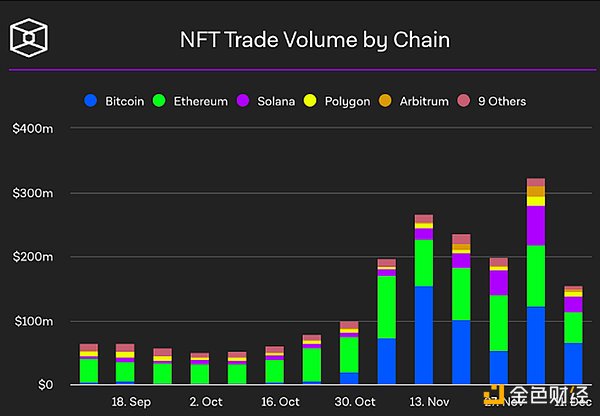

Bitcoin NFTs are becoming increasingly popular, such as OnChain Monkey NFTs and Bitcoin’s price doubled after consolidation, a sign of growing user curiosity. This will naturally lead users to further explore the Bitcoin ecosystem, eager to delve deeper into other use cases such as DeFi and gaming. While this curiosity paves the way for significant shifts, much innovation remains at the protocol level, with inherent limitations in transaction speed, smart contract compatibility, and scalability.
For example, many early projects in the ecosystem are unable to issue products with the same capabilities as the previous generation of Ethereum. Tokens with the same utility and governance capabilities as currencies (for example, BRC-20 and ERC-20).
Therefore, these projects must rely on equity financing and cannot guide the community through their own tokens.
Solutions include issuing fungible tokens on Stacks, which provides smart contract functionality with the SIP-10 fungible token standard or other emerging token standards.
Two-way bridges are emerging, such as MultiBit for cross-network transfers between BRC-20 and ERC-20 tokens. However, these solutions are not the end-all-be-all.
Continuous innovation is critical to meeting these challenges. L2 continues to make increasing progress in reducing transaction times while inheriting 100% of Bitcoin’s finality. At the same time, innovation is filtering through Bitcoin L1. Despite these challenges, developers and Bitcoin enthusiasts are already experimenting with various use cases.
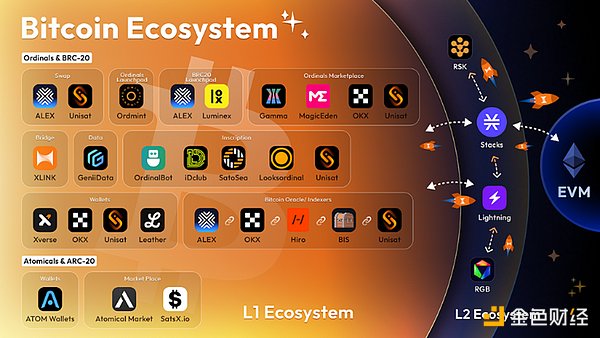
2 . Mid-term outlook: BitcoinL2and emerging use cases achieve breakthroughs
The Bitcoin ecosystem is expected to Major breakthroughs were made in the mid-term, mainly due to advances in L2 technology, such as Stacks’ Nakamoto Release and the launch of sBTC. These developments are not only incremental, but transformative, especially in Bitcoin DeFi and other application areas.
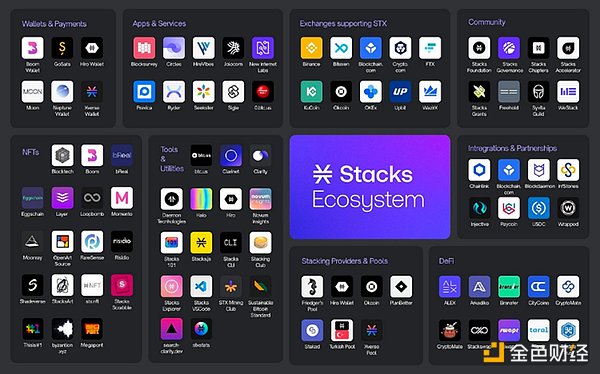
Block time Significant reductions (from over 10 minutes to 5 seconds) and increased security help create a smooth “Ethereum-like” user experience, which is essential for attracting new developers and catalyzing a new wave of adoption and innovation Crucial.
The implementation of fast blocks and sBTC will enable Stacks to provide high-performance, BTC-led applications such as NFT Marketplace that facilitate more efficient trading of Ordinals and unique L2 NFTs.
Bitcoin DeFi is expected to experience considerable expansion, for example lending will be enabled through sBTC. The Zest protocol team has already carried out this construction on Stacks in advance.
ALEX is preparing for all DeFi features, recently surpassed 500 million transaction volume, and has laid the foundation for an sBTC-denominated exchange market for other sub-tokens. These different applications can generate automatic income based on Stacks and allow users to explore and try them out.
Unlock Bitcoin market cap by creating a user adoption flywheel like Ethereum. As the infrastructure continues to mature, a range of new use cases will emerge across all Bitcoin layers, attracting end users. The Bitcoin ecosystem not only has the largest potential TVL in the industry, but also has a larger target audience to build for mainstream users. Key developments in building the ecosystem for success are:
Trust Machines is building Bit Coin Application, whose goal is to grow the Bitcoin economy by demonstrating new use cases for Bitcoin, thereby maximizing the value of the network.
In response to the expected influx of developers, Hiro is stepping up its efforts to build developer tools across Bitcoin layers.
Wallets like Xverse, Leather, and Ryder are focused on a seamless user experience for mass adoption and are compatible with various assets at the Bitcoin layer.
Large centralized exchanges opened the Ordinal market soon after Ordinals became popular, such as Binance, Magic Eden and OKX. Other markets also emerged quickly, including Ordzaar, Gamma, etc. On-chain Monkey also recently launched its own marketplace, Osura.
Others of note are Ordz Games, which launched the first Bitcoin-based game, which released the BRC-20 token $OG.
New Bitcoin City, a project equivalent to friend.tech, was developed and built on Bitcoin L2 NOS by Trustless Computer. Its TVL in October 2023 exceeded US$1 million.
StackingDAO launched liquidity STX (stSTX) in December 2023, bringing liquidity staking functionality to Stacks.
In addition, Darewise, a subsidiary of Animoca Brands, is creating a virtual world based on Ordinals, demonstrating the possibility of continuous expansion within the Bitcoin ecosystem.
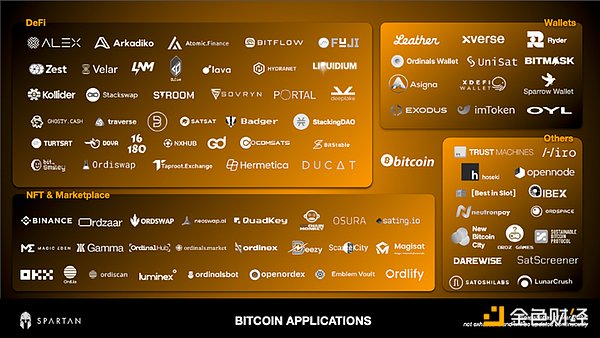
Ultimately, this L2driven expansion of the Bitcoin ecosystem will not only add new features and attract new users, but also more intelligently integrate Bitcoin into the global blockchain economy . Projects like ALEX are at the forefront of this movement, designing permissionless yield stablecoins native to BTC as well as BTC cross-chain bridges (like XLink) that connect Bitcoin to Ethereum and other ecosystems. These initiatives are critical to fostering a Bitcoin ecosystem that is not only more connected but also more productive and, in the long term, lays the foundation for a variety of financial innovations and services across the industry.
In addition, the development of further scaling solutions on Stacks will significantly enhance the interoperability of the Bitcoin ecosystem with other L2 blockchain networks. With the upcoming Nakamoto upgrade, Stacks will introduce new subnets compatible with various programming languages and execution environments, including EVM subnets and Rust VM. Additionally, efforts to integrate WASM support directly on Stacks L2 are ongoing and will be launched in conjunction with the Nakamoto upgrade. In December 2023, a working group within the Stacks ecosystem released details about ClarityWASM’s new virtual machine integration. This integration will open the door to a wider range of languages (such as Rust, Solidity, etc.) directly within the Stacks L2 environment.
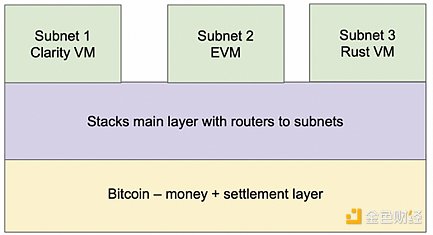
3 Long-term outlook: Paving the way for institutional adoption
Bitcoin’s long-term outlook will solidify its position as a leader in institutional digital asset and DeFi adoption. A Bitcoin spot ETF is expected to be approved, a key milestone that could revolutionize institutional participation in Bitcoin. This approval is expected to bring about a major paradigm shift, with institutions increasingly focusing on Bitcoin-centric financial products and services. Bitcoin is considered a resilient and thoroughly vetted asset class that is on the verge of widespread institutional adoption.
With the approval of a Bitcoin spot ETF, demand for “Bitcoin-native” trading and income products is expected to surge, driven by its security and tax efficiency. This rising interest may spur the development of a variety of regulated Bitcoin financial products. Recognizing this shift, traditional banks may begin to integrate Bitcoin and these new products with their private blockchains, allowing them to serve institutional clients at scale.
The significance of institutions integrating into the Bitcoin DeFi ecosystem is not just capital injection, but also represents the creation of a unique synergy that combines the advantages of traditional finance with the subversiveness of the decentralized financial system. . This integration based on the security and transparency of Bitcoin will redefine the institutional financial landscape and blur the boundaries between the traditional financial system and the modern financial system.
From cultural shifts to technological innovation to institutional adoption, these developments will significantly increase Bitcoin’s market cap and total value locked (TVL) within its ecosystem. As we navigate this decentralized financial future, it’s clear that Bitcoin will be not just a digital asset, but the cornerstone of a new, trustless financial paradigm.
4, Summary
Bitcoin’s evolution from a dormant asset to a dynamic foundation for decentralized finance technology, whose development is driven by its market capitalization of more than $850 billion, as well as the stability and security of the network. However, a key challenge is the underutilization of Bitcoin network capabilities, a consequence of the often overlooked distinction between the Bitcoin network and the Bitcoin digital asset. In order to activate this dormant capital and realize the full potential of the Bitcoin network, network performance must be harnessed to transform Bitcoin from a mere store of value into a core infrastructure in the Bitcoin economy.
This shift is reflected in Bitcoin's development of "layers" on top of its core network (L1) to solve scalability issues, taking inspiration from Ethereum's scalability and flexibility, and through The introduction of Ordinals to promote development marks a shift in culture and development. While major L1 upgrades like SegWit and Taproot have alleviated the problem to some extent, rising transaction fees highlight the rising demand for more advanced L2 solutions like Stacks.
As we get closer to the 2024 halving event and anticipating the approval of a Bitcoin spot ETF, Bitcoin’s development is promoting a more scalable and secure ecosystem. form. This evolution is expected to spur significant institutional adoption, with Bitcoin at the forefront of a new financial paradigm that seamlessly integrates traditional and decentralized systems. The potential of Bitcoin smart contracts, especially in the context of the cultural influence of Ordinals and the expanding use cases for DeFi and gaming, may attract more interest and capital.
In the medium term, breakthroughs in Bitcoin L2 technology, especially the release of Stacks Nakamoto and the launch of sBTC, are expected to completely change the DeFi landscape. These developments are expected to create a smoother and more efficient user experience, opening up new possibilities for Bitcoin-based NFT markets and DeFi applications.
In the long term, Bitcoin will become a key player in institutional adoption of digital assets and DeFi, especially with the potential approval of the first Bitcoin spot ETF. This event may trigger a major shift in institutional investment towards Bitcoin-based financial products and services, enhancing the synergy between the traditional financial system and the decentralized financial system. This collaborative integration is not only about capital injection, but also the integration of the advantages of both parties, paving the way for a new era of institutional finance.
Together, these developments are expected to significantly increase Bitcoin’s market capitalization and the total value locked within its ecosystem, marking a new chapter in the future of decentralized finance. With innovations like Ordinals, the launch of Nakamoto, and Stacks’ sBTC, and the potential for institutional adoption of Bitcoin once the Bitcoin Spot ETF is approved, Bitcoin is not only maintaining its relevance but will actively reshape the future of finance as a new , the cornerstone of the trustless financial paradigm.
 JinseFinance
JinseFinance
 JinseFinance
JinseFinance JinseFinance
JinseFinance JinseFinance
JinseFinance JinseFinance
JinseFinance JinseFinance
JinseFinance JinseFinance
JinseFinance Xu Lin
Xu Lin JinseFinance
JinseFinance Huang Bo
Huang Bo Cointelegraph
Cointelegraph